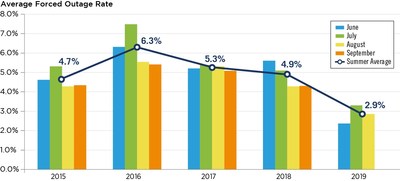VALLEY FORGE, Pa., Oct. 9, 2019 /PRNewswire/ -- The electric grid operated by PJM Interconnection in 13 states and Washington, D.C., reliably served 65 million people in its territory this summer, thanks to cooperation from its member companies and improved generator performance.
PJM's Summer Operations of the PJM Grid: June 1, 2019 – Sept. 15, 2019 shows that the grid continues to have diverse and reliable electricity supplies. The summer as a whole featured relatively mild weather, but also included a record for weekend demand of more than 150,000 MW amid a heat wave in July. The system throughout featured significantly lower generator outages and stable prices.
Demand, or load, peaked at over 152,000 MW on July 19. PJM's all-time, one-day highest power use was recorded in the summer of 2006 at 165,563 MW.
Michael E. Bryson, senior vice president – Operations, said that the evolution of the system, characterized by sophisticated and responsive resources, enforceable performance standards and planned transmission improvements, has helped ease the stress on the grid during high summer loads. "We appreciate the cooperation and coordination with our member utility companies," Bryson said.
"The system would not have handled these high demands as smoothly a decade ago," said Kevin Hatch, supervisor, system operations – Dispatch. "We are seeing generators that are increasingly responsive to our operational requests, a transmission system that is more robust, and the benefits of efficient and reliable resources through the capacity market."
No emergency procedures were called beyond Hot Weather Alerts during five-different periods throughout the summer, the lowest number of emergency procedures in the last five years. Hot Weather Alerts serve to prepare for potential capacity issues brought on by extreme hot or humid weather and accompanying high electricity demand.
PJM considers the summer period to last from June 1 to Sept. 15 each year. Much of the PJM footprint did experience unseasonably warm weather and corresponding high demand on Oct. 1 and 2, however, which resulted in PJM calling on demand response resources.
Those events are outside the scope of this report, but PJM will discuss them at the Oct. 15 meeting of the Operating Committee, when the findings of the Summer Performance Report will also be reviewed.
Forced Outage Rates Improve
The system is becoming more reliable as the capacity market incentivizes and phases in better-performing resources and capacity performance requirements – which reward resources that perform during times of system stress and penalize those that fail to perform. Generator performance is assessed by whether the unit produces electricity when called upon if it had not been previously scheduled for maintenance. If the unit cannot perform, it is considered to be on a forced outage. The average forced outage rate of all the units in the PJM region dropped from nearly 5 percent last summer to less than 3 percent this year, which is the lowest rate in five years.
This is part of a larger trend of decreasing outage rates, which is driving down the required reserve requirement in PJM, reducing wholesale costs to customers. "More efficient generators mean fewer outages, greater reliability and a more efficient system overall," Bryson said.
The fuel mix this summer was approximately 37 percent natural gas, 30 percent nuclear, 25 percent coal and 7 percent renewables.
The average daily locational marginal price for electricity was approximately $25/MWh, and price during the daily peak was $46/MWh.
PJM Interconnection, founded in 1927, ensures the reliability of the high-voltage electric power system serving 65 million people in all or parts of Delaware, Illinois, Indiana, Kentucky, Maryland, Michigan, New Jersey, North Carolina, Ohio, Pennsylvania, Tennessee, Virginia, West Virginia and the District of Columbia. PJM coordinates and directs the operation of the region's transmission grid, which includes over 84,236 miles of transmission lines; administers a competitive wholesale electricity market; and plans regional transmission expansion improvements to maintain grid reliability and relieve congestion. PJM's regional grid and market operations produce annual savings of $2.8 billion to $3.1 billion. For the latest news about PJM, visit PJM Inside Lines at insidelines.pjm.com.
 View original content to download multimedia:http://www.prnewswire.com/news-releases/summer-of-2019-on-the-pjm-grid-reliability-powered-by-generator-performance-300934879.html
View original content to download multimedia:http://www.prnewswire.com/news-releases/summer-of-2019-on-the-pjm-grid-reliability-powered-by-generator-performance-300934879.html
SOURCE PJM Interconnection







